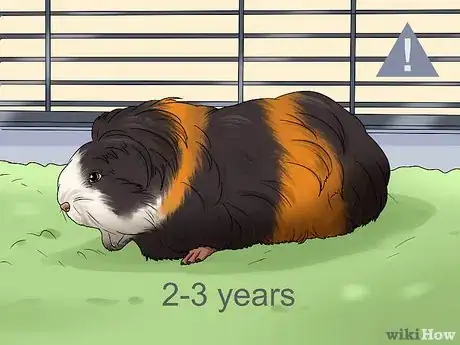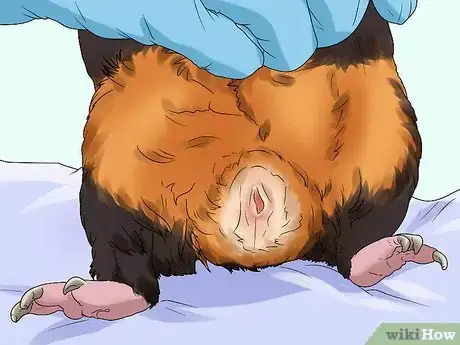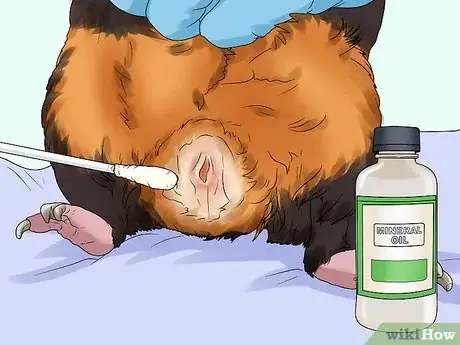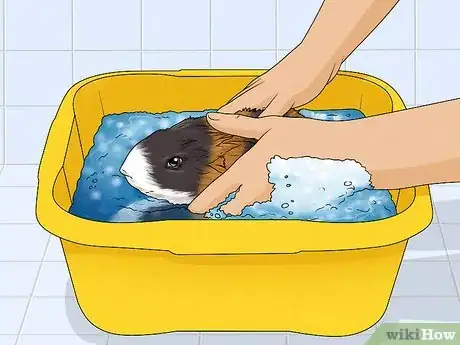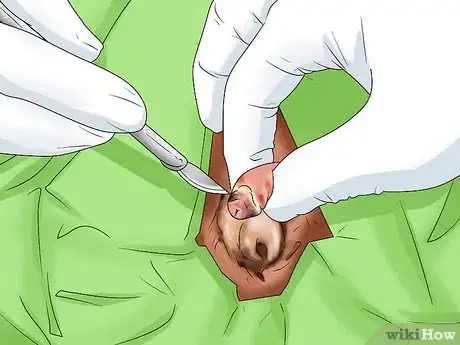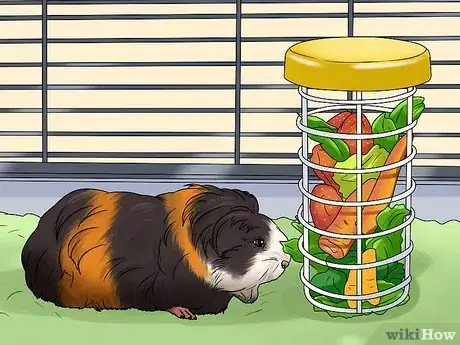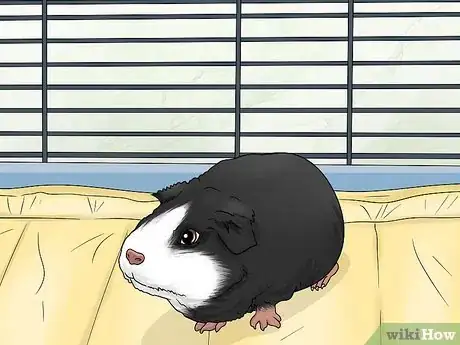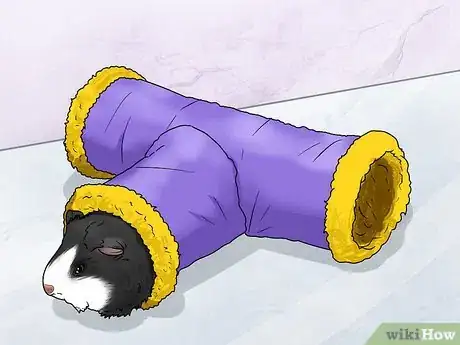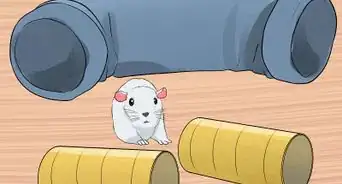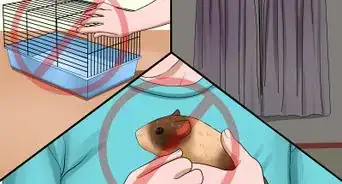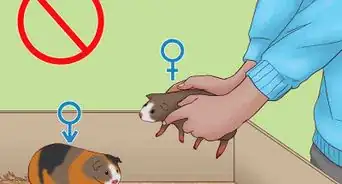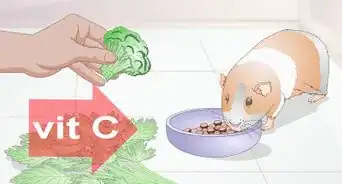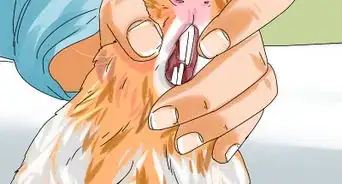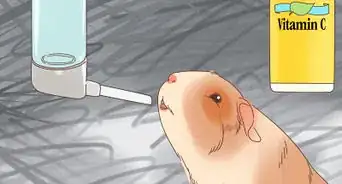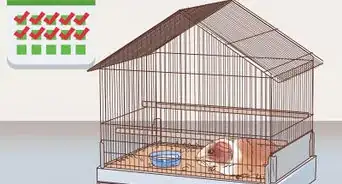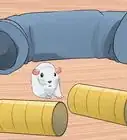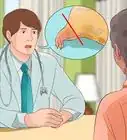X
wikiHow is a “wiki,” similar to Wikipedia, which means that many of our articles are co-written by multiple authors. To create this article, volunteer authors worked to edit and improve it over time.
This article has been viewed 8,706 times.
Learn more...
Faecal impaction is a medical condition that affects both male and female guinea pigs, but is more commonly seen in adult male guinea pigs.[1] The exact reason for its occurrence is unknown, but it can be prevented and treated through a number of ways.
Steps
Part 1
Part 1 of 2:
Treating Impaction
-
1Know if your guinea pig is at risk. While faecal impaction can affect female guinea pigs, it is most common in adult boars older than 2-3 years of age.[2] The exact cause is unknown, but it's suggested that older boars are at a heightened risk due to the increased size of the testes and weakened muscles.[3]
-
2Identify if your guinea pig is suffering from impaction. The easiest method of diagnosing impaction in guinea pigs is to examine their underside area carefully. If your guinea pig is experiencing faecal impaction, you will notice a build-up of droppings in the rectum.[4]
- Other signs of impaction include symptoms of straining or difficult defecating and an unusual odour.[5]
Advertisement -
3Book an appointment with a vet. It's important to seek professional assistance for diagnosis and treatment, as faecal impaction can worsen and cause infection if left untreated. Your veterinarian will be able to diagnose the issue and offer advice for treatment.
- If an infection is present, you will likely need to administer antibiotic medication to your guinea pig. Your veterinarian will show you how.
-
4Clean the affected area routinely. Gently place your guinea pig on their back and smear mineral oil around the affected area using a Q-tip. Gently push down on the bottom side of the area and ease the impacted mass out.[6]
- You may need to do this several times a day or as little as once a week based on the instructions given by your vet.[7]
- If you're unsure how to clean the affected area, contact your veterinarian and request for them to provide a physical demonstration.
-
5Bathe your guinea if necessary. You can also give your guinea pig a bath near the affected area with mild soap or a small animal shampoo. Submerge your guinea pig's hind quarters in shallow warm water in a washing up basin and pull the water over their back end.
- Massage the shampoo into a lather gently around the underside and thoroughly rinse with warm water.
- Bathing your guinea pig will not get rid of the impaction, but it will soften the mass; making it easier to remove.
-
6Adjust your guinea pig's diet. An increased diet of fibre will help treat and prevent impaction. Seek specific instructions from your vet on how you should adjust your guinea pig's diet. Guinea pigs are sensitive to digestive changes, so it's important to switch their diet gradually.[8]
- Provide your guinea pig with large bundles of fresh, grassy hay, such as timothy, to encourage them to consume more fibre.
- Feed your guinea pig one cup of high-fibre vegetables a day, such as cucumber, broccoli, and carrot. Apples and bananas also offer high fibre, but should be fed sparingly due to their high sugar content.[9]
- Your veterinarian may also administer medical-grade fibre pellets to feed to your guinea pig in place of their normal pellets.
-
7Improve your guinea pig's hydration. Ensure your guinea pig is drinking enough water by providing them with easy access to their water bottle or bowl. Replace your guinea pig's water everyday to prevent bacteria build-up.
- Your guinea pig should drink approximately 100ml (3.3 ounces) of water a day.[10] Consider purchasing a bottle with measurements to determine how much water your guinea pig consuming.
- Do not add vitamin drops to your guinea pig's water unless advised by a vet, as doing so may cause your guinea pig to refuse to drink.[11] If you notice a refusal to drink due to vitamin drops, contact your vet.
- Feed your guinea pig water-rich vegetables, like cucumber, tomato, and celery. Avoid lettuce, as it's low in fibre and can cause adverse effects.
-
8Administer medication and supplements to your guinea pig if required. Following your vet's instructions, you may need to administer antibiotics or fluids to your guinea pig, especially if they are suffering from an infection.
- Enquire to your vet about vitamin B-complex supplements. Your vet may instruct you to syringe-feed your guinea pig 25mg a day dissolved in water.[12]
Tip: You can purchase special fibre supplements from your veterinary clinic or pet store if advised by a vet.
Advertisement
Part 2
Part 2 of 2:
Preventing Impaction
-
1Neuter your male guinea pig. Because impaction is commonly caused by an increased size of testes and fat deposit in the genital region, the most effective method of preventing impaction is to desex your boar.[13]
-
2Increase your guinea pig's fibre intake. Large amounts of fibre help prevent impaction and soften stools. Avoid a drastic change in your guinea pig's diet. You should introduce new foods, especially vegetables, gradually.[16]
- Encourage your guinea pig to consume more hay by placing large bundles inside of their cage unrestricted. Do not use hay racks.
- Apple and banana help to soften stools, but should be fed sparingly due to their high sugar content.[17]
-
3Improve your guinea pig's hydration. Faecal impaction can be prevented by ensuring your guinea pig is hydrated to loosen their stools. Install a water bottle or bowl in an easily accessible area of the cage. Clean and replace their water bottle with fresh water every day to prevent bacterial build-up.
- Feed your guinea pig vegetables with a high water content from time to time, such as cucumber and tomatoes. Avoid feeding your guinea pig lettuce, as they are low in fibre which can cause adverse effects.
-
4Switch to a different bedding. If you notice wood shavings or hay stuck to your guinea pig's underside, it's best to switch to a fleece bedding to prevent impaction.[18]
- Do not restrict your guinea pig's hay. Keep the hay in one spot of the cage as opposed to scattered about on the floor. Refrain from using hay racks.
-
5Ensure your guinea pig is receiving enough exercise. Adequate exercise can prevent impaction by strengthening your guinea pig's muscles in their back region.[19] To increase exercise, provide your guinea pig with a large cage with obstacles, such as ramps, tunnels, bridges, and steps. However, do not overcrowd their cage with toys.
- You can also introduce your guinea pig to floor time to encourage your guinea pig to exercise routinely.
Advertisement
Warnings
- Mineral oil is required to clean the impacted area. Use of other oils may cause irritation, infection, or severe bodily harm to your guinea pig.⧼thumbs_response⧽
- Failing to perform this process delicately can cause severe injury to your guinea pig. Request for a physical demonstration by your vet before your attempt to treat the impacted area.⧼thumbs_response⧽
- Do not feed your guinea pig lettuce, such as iceberg or romaine, as it's low in fibre content, which can cause adverse effects.⧼thumbs_response⧽
Advertisement
References
- ↑ https://www.unusualpetvets.com.au/faecal-impaction-in-guinea-pigs/
- ↑ https://www.unusualpetvets.com.au/wp-content/uploads/2018/05/Feacal-Impaction-in-Guinea-Pigs.pdf
- ↑ https://www.guinealynx.info/impaction.html
- ↑ https://www.unusualpetvets.com.au/wp-content/uploads/2018/05/Feacal-Impaction-in-Guinea-Pigs.pdf
- ↑ https://www.unusualpetvets.com.au/faecal-impaction-in-guinea-pigs/
- ↑ https://www.guinealynx.info/impaction.html
- ↑ https://www.unusualpetvets.com.au/wp-content/uploads/2018/05/Feacal-Impaction-in-Guinea-Pigs.pdf
- ↑ https://www.guinealynx.info/impaction.html
- ↑ https://www.med.umich.edu/mott/pdf/mott-fiber-chart.pdf
- ↑ https://lafeber.com/mammals/guinea-pigs-drink/#:~:text=Guinea%20pigs%20normally%20drink%20about,%2C%20activity%20level%2C%20or%20illness
- ↑ https://www.guinealynx.info/diet.html#water
- ↑ https://www.guinealynx.info/impaction.html
- ↑ https://www.unusualpetvets.com.au/wp-content/uploads/2018/05/Feacal-Impaction-in-Guinea-Pigs.pdf
- ↑ https://www.unusualpetvets.com.au/wp-content/uploads/2018/05/Feacal-Impaction-in-Guinea-Pigs.pdf
- ↑ https://www.guinealynx.info/impaction.html
- ↑ https://www.guinealynx.info/impaction.html
- ↑ https://www.med.umich.edu/mott/pdf/mott-fiber-chart.pdf
- ↑ https://www.guinealynx.info/impaction.html
- ↑ https://www.guinealynx.info/impaction.html
About This Article
Advertisement
